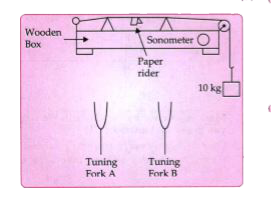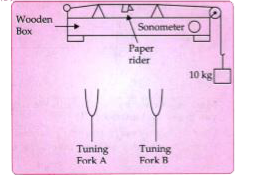The stem of a vibrating tuning fork is pressed against a table top.
Does it cause the table top to set in vibrations ? If yes, what type of vibrations are they?
Step-by-Step Solution:
1. Understanding the Scenario:
- We have a vibrating tuning fork, which means it is producing sound waves due to its vibrations. The stem of this tuning fork is pressed against a tabletop.
2. Effect of the Tuning Fork on the Tabletop:
- When the vibrating tuning fork is pressed against the tabletop, the vibrations from the tuning fork are transferred to the tabletop. This is because the tuning fork is in contact with the tabletop, and the vibrations travel through the material.
3. Vibrations of Atoms in the Tabletop:
- The point of contact between the tuning fork and the tabletop causes the atoms in the tabletop to vibrate. As the tuning fork moves up and down, it disrupts the equilibrium of the atoms in the tabletop, causing them to oscillate.
4. Nature of Vibrations:
- The vibrations of the atoms in the tabletop can be described as periodic oscillations. This means that the atoms are moving back and forth around their equilibrium positions.
5. Production of Waves:
- As the atoms in the tabletop oscillate, they create waves in the material. A wave is characterized by particles moving in one direction (up and down) while the wave itself travels in another direction (horizontally across the tabletop).
6. Conclusion on Type of Vibrations:
- Since the vibrations of the tabletop atoms are induced by the external force of the vibrating tuning fork, these vibrations are classified as forced oscillations. Forced oscillations occur when an external force causes a system to vibrate.
Final Answer:
Yes, the tuning fork causes the tabletop to set in vibrations. These vibrations are called forced oscillations.
- We have a vibrating tuning fork, which means it is producing sound waves due to its vibrations. The stem of this tuning fork is pressed against a tabletop.
- When the vibrating tuning fork is pressed against the tabletop, the vibrations from the tuning fork are transferred to the tabletop. This is because the tuning fork is in contact with the tabletop, and the vibrations travel through the material.
- The point of contact between the tuning fork and the tabletop causes the atoms in the tabletop to vibrate. As the tuning fork moves up and down, it disrupts the equilibrium of the atoms in the tabletop, causing them to oscillate.
- The vibrations of the atoms in the tabletop can be described as periodic oscillations. This means that the atoms are moving back and forth around their equilibrium positions.
- As the atoms in the tabletop oscillate, they create waves in the material. A wave is characterized by particles moving in one direction (up and down) while the wave itself travels in another direction (horizontally across the tabletop).
- Since the vibrations of the tabletop atoms are induced by the external force of the vibrating tuning fork, these vibrations are classified as forced oscillations. Forced oscillations occur when an external force causes a system to vibrate.
Yes, the tuning fork causes the tabletop to set in vibrations. These vibrations are called forced oscillations.
Topper's Solved these Questions
- SOUNDBOOK - ICSECHAPTER - SOUNDEXERCISE - EXERCISE -7(A)
20 Videos
- SOUNDBOOK - ICSECHAPTER - SOUNDEXERCISE - EXERCISE -7(A) (MULTIPLE CHOICE TYPE)
2 Videos
- SIMPLE MACHINES BOOK - ICSECHAPTER - SIMPLE MACHINES EXERCISE - DIAGRAM BASED MCQ
5 Videos
- SPECIMEN PAPER (SOLVED)BOOK - ICSECHAPTER - SPECIMEN PAPER (SOLVED)EXERCISE - SECTION II
78 Videos
Similar Questions
The stem of a vibrating tuning fork is pressed against a table top.
Will it produce an audible sound ?
View SolutionThe stem of a vibrating tuning fork is pressed against a table top.
Under what condition does it lead to resonance ?
View SolutionWhen the stem of a vibrating tuning fork is gently pressed on the surface of a table louder sound is heard. Why?
View Solution
The diagram above shows a wire stretched over a sonometer. Stems of two vibrating tuning forks A and B are touched to the wooden box of the sonometer. It is observed that the paper rider (a small piece of paper folded at the centre) present on the wire flies off when the stem of vibrating tuning fork B is touched to the wooden box but the paper just vibrates when the stem of vibrating tuning fork A is touched to the wooden box.
Why does the paper rider fly off when the stem of tuning fork B is touched to the box ?
View SolutionThe diagram below shows a wire stretched over a sonometer. Stems of two vibrating tuning forks A and B are touched in turn to the wooden box of the sonometer. It is observed that the paper rider (a small piece of paper folded at the centre) present on the wire flies off when the stem of vibrating tuning fork B is touched to the wooden box but the paper just vibrates when the stem of vibrating tuning fork A is touched to the wooden box.

Name the phenomenon when the paper rider just vibrates.
View Solution
The diagram above shows a wire stretched over a sonometer. Stems of two vibrating tuning forks A and B are touched to the wooden box of the sonometer. It is observed that the paper rider (a small piece of paper folded at the centre) present on the wire flies off when the stem of vibrating tuning fork B is touched to the wooden box but the paper just vibrates when the stem of vibrating tuning fork A is touched to the wooden box.
Name the phenomenon when the paper rider flies off.
View SolutionAssertion: A vibrating tuning fork sounds louder when its stem is pressed against a desk top.
Reason : When a wave reaches another denser medium, part of the wave is reflected.
View SolutionA tuning fork is vibrating in air. State whether the vibrations are natural or damped ?
View SolutionA vibrating tuning fork is first held in the hand and then its end is broght in contact with a table. Which of the following statement (s) is are correct in respect of this situation?
View SolutionA vibrating tuning fork is first held in the hand and then its end is broght in contact with a table. Which of the following statement (s) is are correct in respect of this situation?
View Solution
